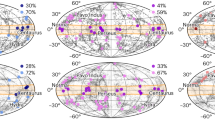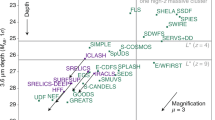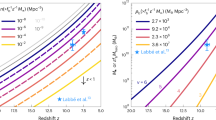Abstract
Recent observations1,2 of high-redshift supernovae seem to suggest that the global geometry of the Universe may be affected by a ‘cosmological constant’, which acts to accelerate the expansion rate with time. But these data by themselves still permit an open universe of low mass density and no cosmological constant. Here we derive an independent constraint on the lower bound to the mass density, based on deviations of galaxy velocities from a smooth universal expansion3,4,5,6,7. This constraint rules out a low-density open universe with a vanishing cosmological constant, and together the two favour a nearly flat universe in which the contributions from mass density and the cosmological constant are comparable. This type of universe, however, seems to require a degree of fine tuning of the initial conditions that is in apparent conflict with ‘common wisdom’.
This is a preview of subscription content, access via your institution
Access options
Subscribe to this journal
Receive 51 print issues and online access
$199.00 per year
only $3.90 per issue
Buy this article
- Purchase on Springer Link
- Instant access to full article PDF
Prices may be subject to local taxes which are calculated during checkout

Similar content being viewed by others
References
Perlmutter,S. et al. Measurements of Ω and Λ from 42 high-redshift supernovae. Astrophys. J. 517, 565–586 (1999).
Riess,A. G. et al. Observational evidence from supernovae for an accelerating universe and a cosmological constant. Astron. J. 116, 1009–1038 (1998).
Dekel,A. & Rees,M. J. Ω from velocities in voids. Astrophys. J. 422, L1–L4 (1994).
Nusser,A. & Dekel,A. Ω and the initial fluctuations from velocity and density fields. Astrophys. J. 405, 437–448 (1993).
Bernardeau,F., Juszkiewicz,R., Dekel,A. & Bouchet,F. R. Omega from the skewness of the cosmic velocity divergence. Mon. Not. R. Astron. Soc. 274, 20–26 (1995).
Zaroubi,S., Zehavi,I., Dekel,A., Hoffman,Y. & Kolatt,T. Large-scale power spectrum from peculiar velocities via likelihood analysis. Astrophys. J. 486, 21–31 (1997).
Freudling,W. et al. Large-scale power spectrum and cosmological parameters from SFI peculiar velocities. Astrophys. J. 532, (in the press); also as preprint astro-ph/9904118 (1999).
Carroll,S. M., Press,W. H. & Turner,E. L. The cosmological constant. Annu. Rev. Astron. Astrophys. 30, 499–542 (1992).
Willick,J. A. et al. Homogeneous velocity–distance data for peculiar velocity analysis. III. The Mark III catalog of galaxy peculiar velocities. Astrophys. J. (suppl.) 109, 333–366 (1997).
Haynes,M. P. et al. The I-band Tully–Fisher relation for Sc galaxies: optical imaging data. Astron. J. 117, 1668–1687 (1999).
Haynes,M. P. et al. The I-band Tully–Fisher relation for Sc galaxies: 21 centimeter HI line data. Astron. J. 117, 2039–2051 (1999).
Dekel,A. et al. POTENT reconstruction from Mark III velocities. Astrophys. J. 522, 1–38 (1999).
Dekel,A., Bertchinger,E. & Faber,S. M. Potential, velocity, and density fields from sparse and noisy redshift-distance samples: Method. Astrophys. J. 364, 349–369 (1990).
Sugiyama,N. Cosmic background anisotropies in cold dark matter cosmology. Astrophys. J. (suppl.) 100, 281–305 (1995).
Sigad,Y., Eldar,A., Dekel,A., Strauss,M. A. & Yahil,A. IRAS versus POTENT density fields on large scales: biasing and omega. Astrophys. J. 495, 516–532 (1998).
Eke,V. R., Cole,S., Frenk,C. S. & Henry,P. J. Measuring Ω0 using cluster evolution. Mon. Not. R. Astron. Soc. 298, 1145–1162 (1998).
Dekel,A. & Lahav,O. Stochastic nonlinear galaxy biasing. Astrophys. J. 520, 24–34 (1999).
Bunn,E. F. & White,M. The four-year COBE normalization and large-scale structure. Astrophys. J. 480, 6–21 (1997).
Lahav,O., Lilje,P. B., Primack,J. R. & Rees,M. J. Dynamical effects of the cosmological constant. Mon. Not. R. Astron. Soc. 251, 128–136 (1991).
Riess,A. G., Press,W. H. & Kirshner,R. P. A precise distance indicator: type Ia supernova multicolour light-curve shape. Astrophys. J. 473, 88–109 (1996).
Freedman,W. L. in Critical Dialogues in Cosmology (ed. Turok, N.) 92–129 (World Scientific, Singapore, 1997).
Bond,J. R. & Jaffe,A. H. Constraining large scale structure theories with the cosmic background radiation. Phil. Trans. R. Soc. Lond. A (in the press); also as preprint astro-ph/9809043 (1998).
Weinberg,S. The cosmological constant problem. Rev. Mod. Phys. 61, 1–23 (1989).
Chaboyer,B., Demarque,P., Kernan,P. J. & Krauss,L. M. The age of globular clusters in light of Hipparcos: Resolving the age problem? Astrophys. J. 494, 96–110 (1998).
Efstathiou,G., Bridle,S. L., Lasenby,A. N., Hobson,M. P. & Ellis,R. S. Constraints on ΩΛ and Ωm from distant type Ia supernovae and cosmic microwave background anisotropies. Mon. Not. R. Astron. Soc. 303, L47–L52 (1999).
Lineweaver,C. H. The cosmic microwave background and observational convergence in the Ωm–ΩΛ plane. Astrophys. J. 505, L69–L73 (1998).
Tegmark,M., Eisenstein,D. J., Hu,W. & Kron,R. Cosmic complementarity: probing the acceleration of the universe. Astrophys. J. (submitted); also as preprint astro-ph/9805117 (1998).
White,M. Complementary measures of the mass density and cosmological constant. Astrophys. J. 506, 495–501 (1998).
Lasenby,A. W., Jones,A. W. & Dabrowski,Y. Observations of the cosmic microwave background and implications for cosmology and large scale structure. Phil. Trans. R. Soc. Lond. A (in the press); also as preprint astro-ph/9810196 (1998).
Zaldarriaga,M., Spergel,D. N. & Seljak,U. Microwave background constraints on cosmological parameters. Astrophys. J. 488, 1–13 (1997).
Acknowledgements
We thank the Mark III and SFI teams, including D. Burstein, S. Courteau, L. N. daCosta, A. Eldar, S. M. Faber, W. Freudling, R. Giovanelli, M. P. Haynes, T. Kolatt, J. J. Salzer, M. A. Strauss, G. Wagner, J. A. Willick, A. Yahil and S. Zaroubi. We thank G. R. Blumenthal and O. Lahav for discussions. This research was supported by US–Israel Binational Science Foundation and Israel Science Foundation grants at the Hebrew University and by DOE and NASA grants at Fermilab.
Author information
Authors and Affiliations
Corresponding authors
Rights and permissions
About this article
Cite this article
Zehavi, I., Dekel, A. Evidence for a positive cosmological constant from flows of galaxies and distant supernovae. Nature 401, 252–254 (1999). https://doi.org/10.1038/45748
Received:
Accepted:
Issue Date:
DOI: https://doi.org/10.1038/45748
This article is cited by
-
Stochastic evolution of the Universe: A possible dynamical process leading to fractal structures
Pramana (2018)
-
On the Inherent Incompleteness of Scientific Theories
Activitas Nervosa Superior (2011)
-
Transverse wave propagation in relativistic two-fluid plasmas around Reissner–Nordström–de Sitter black hole
General Relativity and Gravitation (2010)
-
Classical stochastic approach to cosmology revisited
Pramana (2003)
-
Stochastic evolution of cosmological parameters in the early universe
Pramana (2001)
Comments
By submitting a comment you agree to abide by our Terms and Community Guidelines. If you find something abusive or that does not comply with our terms or guidelines please flag it as inappropriate.



